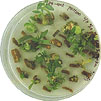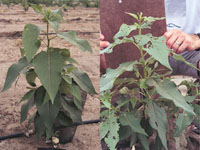

Tree Genetic Engineering Research Cooperative
Oregon State University
A National Science Foundation Industry/University
Cooperative Research Center since 1999
Forest Biotechnology: modifying trees to meet the wood and environmental needs of a growing world

|
Center Mission and Rationale
The Tree Genetic Engineering Research Cooperative (TGERC) seeks to develop
genetic technologies based on research in plant molecular biology that
are likely to have application to forest industries. Key research themes
are genetic control of flowering, environmental analysis of transgenic
plantations, and use of gene transfer for functional genomics. Research
projects are focused on poplars (cottonwoods and aspens) and eucalyptus
as commercial objects and scientific models.
TGERC levers member contributions more than 40-fold through joint member support, through major institutional resources from Oregon State University, and from a number of federal competitive grants. Recent grants for TGERC-associated projects have been obtained from the State of Oregon and the United States Department of Agriculture, Department of Energy, Environmental Protection Agency, Forest Service, and National Science Foundation. Regular members of TGERC contribute to research through financial and in-kind contributions. They help to direct research, receive early notification of research results, and obtain intellectual property benefits. Associate members make in-kind contributions but do not provide financial support or receive intellectual property benefits.

|
Research Products
- Non-flowering trees. Six new genes that play key roles in flower development have been isolated and tested in transgenic plants. They will be useful for engineering male- and female-sterile trees, facilitating regulatory and public approval of transgenic plantations.
- Gene flow from plantations. The extent of gene flow from hybrid plantations to the wild is being studied and used to predict the effects of deploying fertile and sterile transgenic trees with new traits. These analyses are critical for regulatory approval of engineered plantations.
- Gene transfer method. An Agrobacterium-based method was developed
that is effective on a variety of commercial lines of hybrid cottonwoods.
It has been used to generate over 2,000 lines of transgenic poplars
and over 20 field trials of transgenic trees.


- Enhanced transgene expression. A matrix attachment region placed near to genes demonstrated the ability to enhance the rate of transformation, and the level of gene expression, in aspens and cottonwoods. This improves the efficiency of trait delivery in transgenic trees.
- Roundup® resistant trees. Two hundred lines of transgenic aspens and cottonwoods were generated and their tolerance to herbicide studied at three field sites. A number of the lines have demonstrated high levels of tolerance and no detectable growth loss after multiple Roundup(R) applications.
- Insect resistant trees. One hundred lines of transgenic aspens and cottonwoods were generated that contain a synthetic gene from the cry3a strain of Bacillus thuringiensis. All of the lines showed strong resistance to the cottonwood leaf beetle -- a devastating pest of poplars -- and enhanced growth rate.
Center Headquarters
Tree Genetic Engineering Research Cooperative
Department of Forest Science
Oregon State University
Corvallis, OR 97331-5752
Tel (541) 737-6578 * Fax (541) 737-1393
Homepage: www.fsl.orst.edu/tgerc/
Center Director: Dr. Steve Strauss
steve.strauss@orst.edu
Center Evaluator: Dr. Craig S. Scott
(206) 543-2259 * scottcs@u.washington.edu
NSF 01-168q